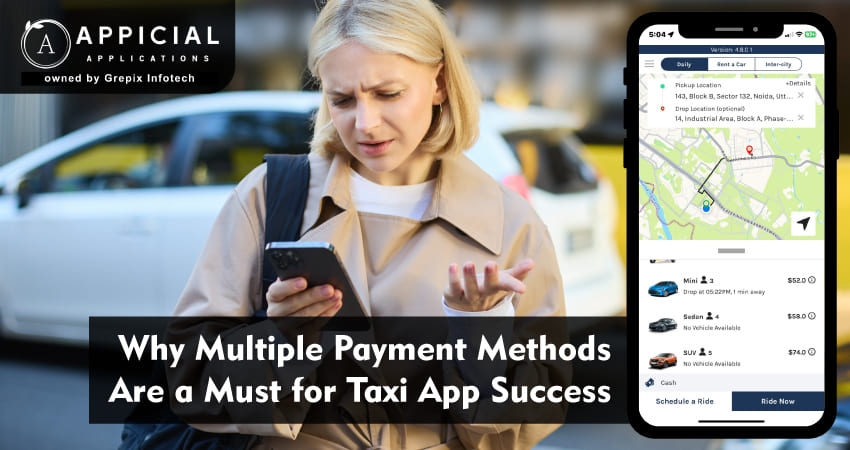
Why Multiple Payment Methods Are a Must for Taxi App Success
In the rapidly evolving world of urban mobility, users increasingly expect their favourite apps to deliver not only convenience in ride booking but also flexible payment options. A modern ride-hailing app cannot rely solely on one payment mode.
For an Uber Clone or white label taxi booking app to stand out, supporting multiple payment methods is no longer optional; it is imperative. A leading taxi app development company must design payment systems that accommodate diverse user preferences, regional behaviours, and future-looking trends. Below, we examine the rationale in depth.
In today’s mobility market, building a successful ride-hailing app or ride-sharing app demands more than basic booking and dispatch features. One of the most crucial differentiators is offering multiple payment methods. Whether you’re developing an Uber Clone, a white label taxi booking app, or contracting a taxi app development company, you must integrate a wide array of payment options, from cards and mobile wallets to cash and in-app wallets to meet user expectations, improve conversion, reduce friction, and expand market reach. This blog explains why multiple payments are essential, explores the benefits and challenges, addresses implementation considerations, and closes with why partnering with Appicial Applications is the right move.
What Drives the Need for Multiple Payment Methods?
Diverse User Preferences and Demographics
Users across geographies vary widely in their payment habits. Some prefer credit or debit cards, others mobile wallets, some rely on cash, and increasingly in some markets, bank transfers or UPI systems. Studies show that in taxi service contexts, around 91% of passengers prefer digital payment options when available. If your ride-sharing app or e-hailing app only supports one payment mode, you immediately exclude a large segment of users. A robust taxi app development company must build in support for cards, wallets, in-app wallets, cash and local payment methods.
Market Competitiveness and User Retention
In the mobility sector, competition is fierce. A platform that offers booking but limits payment methods creates friction at checkout, it leads to drop-offs and lost conversions. Ensuring that your Uber Clone supports multiple payment options strengthens retention and builds trust. For a white label taxi app development company, payment flexibility is a key selling point for clients.
Regional Regulatory and Infrastructure Constraints
In many markets, digital payment infrastructure is heterogeneous. In India, for example, the presence of the Unified Payments Interface (UPI) means users expect instant bank-to-bank transfers besides cards. In markets where cash remains dominant, your ride hailing app must support cash too. A smart taxi app development company will localize payment options to match the region’s financial ecosystem.
Reducing Payment Friction and Boosting Conversion
At the moment of payment is when the user’s patience is lowest. If they cannot pay via their preferred method, they may abandon the ride. The smoother and more flexible the payment, the higher the conversion rate. For a ride sharing app, integrating multiple payment methods helps reduce churn. For a white label taxi booking app, offering this flexibility is a competitive differentiator.
Driver Preferences and Payout Flexibility
On the driver side, payout methods matter too. Drivers often prefer fast, flexible settlements via their preferred bank, wallet, or mobile money. A taxi app development company must build a backend that supports flexible payout options, thereby improving driver satisfaction and supply retention.
What Are the Major Benefits of Supporting Multiple Payment Methods?
Expanded Customer Reach and Inclusivity
By supporting multiple payment methods, your ride-hailing app becomes accessible to a wider audience, including unbanked or under-banked users who may rely on cash or mobile money. The data show that even as card usage rises, many consumers continue to use cash as a complement. A true Uber Clone built by a forward-looking taxi app development company will not ignore these segments.
Higher User Satisfaction and Retention
When users find their preferred payment method available, whether wallet, card, cash, or bank transfer, they feel the app caters to them. That builds loyalty. According to industry insights, when payments are frictionless, users are more likely to use the service again and recommend it. a ride-sharing app, which means higher lifetime value.
Operational Efficiency and Cost Reduction
Digital payment methods reduce cash-handling overhead, reduce driver risk (by eliminating cash), and ease reconciliation and auditing. In one report, mobile POS adoption in taxis allowed drivers to process payments more efficiently and reduce idle time. A white label taxi booking app developed with built-in payment flexibility saves backend logistics cost.
Data Insights and Business Intelligence
Each digital payment generates data: transaction time, payment method, cancellation rate, and rider profile. A well-designed payment module in your ride-hailing app allows the platform to analyse patterns and optimise offers and operations. A taxi app development company should integrate analytics capabilities to make payments a strategic asset, not just a technical feature.
Future-Proofing and Innovation
By building architecture that supports multiple payment methods, including emerging ones (mobile wallets, QR codes, digital wallets, even crypto or contactless), your Uber Clone or white label taxi booking app remains adaptable. Payment technology continues to evolve and your platform must be ready for the next wave.
What Challenges and Considerations Come with Multiple Payment Methods?
Integration Complexity and Technical Overhead
Each additional payment method introduces integration work with different payment gateways, APIs, compliance regimes, and settlement systems. As the blog from the industry pointed out: “Integrating all these preferences through multiple payment gateways adds complexity, but also delivers inclusivity.” A taxi app development company must account for this and ensure scalability, reliability and security.
Security, Fraud and Compliance Risks
With digital payments come risk of fraud, chargebacks, data breaches and regulatory scrutiny (e.g., PCI-DSS). A ride-sharing app must employ tokenisation, encryption, and secure vaults. A white-label taxi app development company must ensure that the payment module meets local and global compliance standards.
Cost of Payment Processing
Different payment methods carry different fees (card fees, wallet commissions). Some methods may cost more and reduce margins if not managed. The ecosystem must balance offering variety with sustainability. A planned approach by a taxi app development company is vital.
User Experience Complexity
Too many choices can paradoxically confuse users. The blog about multiple payment options warned: “Does all this variety make things smoother for passengers, or is it adding unnecessary complexity?” It is important that your ride-hailing app presents payment options in a simple, intuitive way. The UI must guide users rather than overwhelm them.
Localisation and Currency Challenges
If your Uber Clone or white-label taxi booking app operates in multiple regions, you may need to support local currencies, local payment systems (e.g., UPI in India, mobile money in Africa), and compliance with local financial laws. A robust taxi app development company must build a modular payment architecture for localisation.
How Do You Implement Multiple Payment Methods Effectively in Your Ride-Hailing App?
Which Payment Methods Should You Include?
A strong ride-hailing app should include:
- Debit/credit cards (Visa, MasterCard, AMEX)
- Mobile wallets (Apple Pay, Google Pay, Samsung Pay)
- In-app wallet (pre-loaded within your platform)
- Bank transfers/UPI (in regions like India)
- Cash on arrival (if local market demands)
- QR code payments or mobile money (in emerging markets)
- Contactless in-vehicle payments or mPOS (for driver convenience)
When building an Uber Clone, partner with a payment gateway that supports multiple payment methods; your taxi app development company should ensure each method is integrated, tested, and secured.
Design a Seamless Payment UX
Your payment flow in the ride-sharing app should be: easy to access, clearly explained, and with minimal steps. Users should be able to save payment methods securely, choose at the time of ride, and receive receipts. Avoid forcing multiple steps or complicated verification. The blog from Appicial emphasised one-tap checkouts and transparent fare breakdowns. A well-designed white-label taxi booking app will clearly display “Pay via: card/wallet / cash,” with the preferred method pre-selected.
Backend Architecture and Payment Gateway Strategy
Work with your taxi app development company to choose a gateway that supports all desired methods, multi-currency if needed, auto-settlement, reconciliation dashboards, and fraud detection. Use tokenization so card details are not stored on your servers. Build middleware to route payments, monitor settlements, and provide dashboards for drivers and admins.
Driver Payouts and Settlement Options
A key component often overlooked: drivers need flexible payout mechanisms too. The system should allow drivers to receive earnings in a bank, wallet, or other preferred methods, timely and reliably. Your ride-hailing app should provide driver dashboards to view earnings and request payouts. A taxi app development company must build both user and driver-side payment modules symmetrically.
Monitoring, Analytics & Optimisation
Deploy analytics to monitor payment usage: which methods are used most, which cause drop-offs, which markets prefer cash vs wallet. Use this data to refine your Uber Clone offering. Have your white label taxi booking app track failed payment rates, settlement delays, and user disputes. Use insights to negotiate better gateway rates or drop underperforming payment methods.
Compliance, Security & Localisation
Ensure compliance with PCI-DSS, local regulations (for example data protection laws). Localise payment options as per region: wallets popular in one country may not exist in another. In India the UPI system dominates digital payments. A global-ready taxi app development company accounts for localization and data regulations from day one.
Also Read: The Future of Promo Codes and Discounts in Taxi Booking Apps
What Does the Market Data Say?
Size of the Taxi App Market
According to a recent report, the taxi app market is expected to reach USD 283 billion by 2028, growing at a ~4.2% CAGR from 2023 to 2028. This growth validates the importance of building robust platforms, including payment infrastructures. A ride-sharing app with flexible payments is better positioned in that ecosystem.
Digital Payment Preferences
As noted earlier, one study found 91% of passengers prefer digital payment options when available. Also, providers who support multiple payment methods report improved conversion and user satisfaction. For a ride-hailing or e-hailing app, this underscores the need for payment flexibility.
The Role of Payment Methods in App Selection
In comparisons of ride apps, the presence of “Multiple payment methods” is highlighted as a key feature of best-in-class apps. This suggests that when users choose between ride apps, payment options matter. For a strong competitor in the market, your Uber Clone should meet or exceed this expectation; your chosen taxi app development company must deliver it.
Why Choose Appicial Applications for Your Taxi App Payment Integration?
When you are building an Uber Clone, or a ride-hailing app or e-hailing app, selecting the right taxi app development company is crucial. Appicial Applications stands out because:
- They have deep experience designing full-stack taxi platforms, including payment modules, driver dashboards, and user apps.
- They build white label taxi booking apps with multiple payment methods integrated from day one, including cards, mobile wallets, bank transfers, cash flows, and in-app wallets.
- Their architecture supports modular expansion, global localisation, compliance (PCI-DSS, regional financial regs), and includes analytics.
- They offer a user-friendly UX where payment is seamless and intuitive—for both riders and drivers.
- They provide end-to-end services from ideation to deployment and post-launch optimization.
If you are serious about launching a competitive ride-sharing app or Uber Clone with the payment flexibility that modern users expect, Appicial Applications is your go-to partner.
Want to build a high-performance taxi platform with multiple payment methods built in? Contact Appicial Applications today for a free consultation and demo. Get your white label taxi booking app or custom ride-hailing app ready with secure, flexible payments and stand out in the market.
Conclusion
In summary, supporting multiple payment methods is not just a nice-to-have; it is a foundational feature for success in the mobility app domain. Whether you're launching an Uber Clone, a ride-hailing app, or a white label taxi booking app, ensuring that users and drivers can pay and get paid how they prefer is critical. The benefits span improved user experience, broader market reach, operational efficiency, income growth, and competitive differentiation. At the same time, the challenges around integration, cost, UX-design, security, and localisation must be addressed thoughtfully.
Choosing the right taxi app development company ensures you build this correctly. Appicial Applications, with its solid track record, pays special attention to payment integration, driver payouts and analytics, making it a strong partner.
Take action now to ensure your mobility platform is ready for today's demands and tomorrow's innovations.
FAQs
Author's Bio

Vinay Jain is the Founder at Grepix Infotech and brings over 12 years of entrepreneurial experience. His focus revolves around software & business development and customer satisfaction.
Back to blog list




